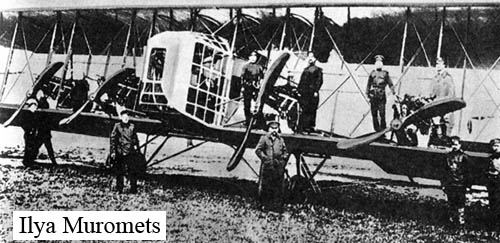Sikorsky's Bomber
Today, young Sikorsky. The University of Houston's College of Engineering presents this series about the machines that make our civilization run, and the people whose ingenuity  created them.
created them.
We know Igor Sikorsky's name from Sikorsky Aircraft -- the helicopter company. Sikorsky designed and built America's first successful helicopter in 1939. Before that, he built civilian airplanes and flying boats. But he came to America from Russia in the near wake of the Revolution, and we want to meet the young Sikorsky:
Born in 1889, he grew up with the new technology of flight. Eight years after the Wright Brothers, he built a very successful early airplane and the Russo-Baltic Railcar Factory immediately hired him to explore the airplane's potential.
Sikorsky's Eureka moment came when engine trouble forced him down in a field -- an all-too common event. When he found that a mere mosquito had clogged his carburetor, he said, "Airplanes are too vulnerable with only one engine." So he built a huge biplane: 92-foot wingspan, four large engines and an enclosed cockpit. People called it The Grand, but it was short-lived. In a bizarre accident the engine fell off an airplane flying over the field. The engine landed on the parked Grand and destroyed it.
So Sikorsky turned right around and made a still grander plane. His Ilya Muromets, I.M. for short, was now the world's largest and most luxurious passenger plane. The I.M. flew a round trip from St Petersburg to Kiev and back in July 1914 -- just days before WW-I.

And here the Russian Army showed real foresight. They'd already begun building war planes. So they placed an order for ten of Sikorsky's great beasts to serve, not as transports, but as bombers. Still, flight was in its cradle, and every step had to be invented in the moment.
The I.M. was a huge departure from the brief twelve year history of flying machines. It was hard to fly -- hard to maintain. The army had no time for it. But the Czar intervened and Sikorsky made rapid improvements. By 1915 I.M.s were inflicting great damage on the Germans and coming home intact.
And they proved to have two kinds of natural protection: They were so big that enemy pilots misjudged their distance and missed when they fired. And when pursuing planes did get close, they were buffeted by a huge propeller wash.
As Germany improved her tactics, Sikorsky improved the I.M. He built a small rail trolley in its body so a crew member could quickly get back to the first bomber tail gun. Attacking I.M.s was dangerous, and they were remarkably robust. Germans managed to shoot down only two of the twenty that were made. I.M.s riddled with bullets and shrapnel still survived. One came back so badly damaged that a wing fell off -- but only after it'd landed safely.
So it was that thirty-year-old Igor Sikorsky came to America as a major pioneer of large multi-engine airplanes; and he went back to evolving the civilian airliner. But helicopters had caught his interest in childhood and in the end they -- not seaplanes, bombers, or airliners -- are where his fame comes to rest.
I'm John Lienhard at the University of Houston, where we're interested in the way inventive minds work.
R. Miller, The Soviet Air Force at War. (Alexandria, VA: Time-Life books, 1983): Chapter 1.
See also the Sikorsky article in Wikipedia.
For more on Sikorsky, helicopters and seaplanes see Episodes 507, 1578, and 1489.
For pictures of early Sikorsky designs, Click Here for a large poster from the New England Air Museum
Images: Ilya Muromets courtesy of Wikipedia. Sikorsky above and the Sikorsky poster link from the New England Air Museum, (Photo by JHL).